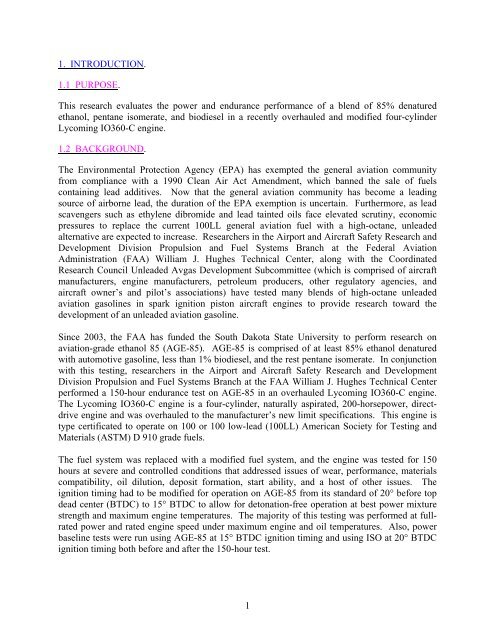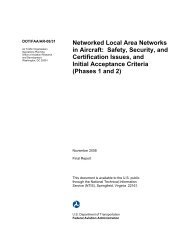Spark Ignition Aircraft Engine Endurance Test of Aviation ... - FAA
Spark Ignition Aircraft Engine Endurance Test of Aviation ... - FAA
Spark Ignition Aircraft Engine Endurance Test of Aviation ... - FAA
Create successful ePaper yourself
Turn your PDF publications into a flip-book with our unique Google optimized e-Paper software.
1. INTRODUCTION.<br />
1.1 PURPOSE.<br />
This research evaluates the power and endurance performance <strong>of</strong> a blend <strong>of</strong> 85% denatured<br />
ethanol, pentane isomerate, and biodiesel in a recently overhauled and modified four-cylinder<br />
Lycoming IO360-C engine.<br />
1.2 BACKGROUND.<br />
The Environmental Protection Agency (EPA) has exempted the general aviation community<br />
from compliance with a 1990 Clean Air Act Amendment, which banned the sale <strong>of</strong> fuels<br />
containing lead additives. Now that the general aviation community has become a leading<br />
source <strong>of</strong> airborne lead, the duration <strong>of</strong> the EPA exemption is uncertain. Furthermore, as lead<br />
scavengers such as ethylene dibromide and lead tainted oils face elevated scrutiny, economic<br />
pressures to replace the current 100LL general aviation fuel with a high-octane, unleaded<br />
alternative are expected to increase. Researchers in the Airport and <strong>Aircraft</strong> Safety Research and<br />
Development Division Propulsion and Fuel Systems Branch at the Federal <strong>Aviation</strong><br />
Administration (<strong>FAA</strong>) William J. Hughes Technical Center, along with the Coordinated<br />
Research Council Unleaded Avgas Development Subcommittee (which is comprised <strong>of</strong> aircraft<br />
manufacturers, engine manufacturers, petroleum producers, other regulatory agencies, and<br />
aircraft owner’s and pilot’s associations) have tested many blends <strong>of</strong> high-octane unleaded<br />
aviation gasolines in spark ignition piston aircraft engines to provide research toward the<br />
development <strong>of</strong> an unleaded aviation gasoline.<br />
Since 2003, the <strong>FAA</strong> has funded the South Dakota State University to perform research on<br />
aviation-grade ethanol 85 (AGE-85). AGE-85 is comprised <strong>of</strong> at least 85% ethanol denatured<br />
with automotive gasoline, less than 1% biodiesel, and the rest pentane isomerate. In conjunction<br />
with this testing, researchers in the Airport and <strong>Aircraft</strong> Safety Research and Development<br />
Division Propulsion and Fuel Systems Branch at the <strong>FAA</strong> William J. Hughes Technical Center<br />
performed a 150-hour endurance test on AGE-85 in an overhauled Lycoming IO360-C engine.<br />
The Lycoming IO360-C engine is a four-cylinder, naturally aspirated, 200-horsepower, directdrive<br />
engine and was overhauled to the manufacturer’s new limit specifications. This engine is<br />
type certificated to operate on 100 or 100 low-lead (100LL) American Society for <strong>Test</strong>ing and<br />
Materials (ASTM) D 910 grade fuels.<br />
The fuel system was replaced with a modified fuel system, and the engine was tested for 150<br />
hours at severe and controlled conditions that addressed issues <strong>of</strong> wear, performance, materials<br />
compatibility, oil dilution, deposit formation, start ability, and a host <strong>of</strong> other issues. The<br />
ignition timing had to be modified for operation on AGE-85 from its standard <strong>of</strong> 20° before top<br />
dead center (BTDC) to 15° BTDC to allow for detonation-free operation at best power mixture<br />
strength and maximum engine temperatures. The majority <strong>of</strong> this testing was performed at fullrated<br />
power and rated engine speed under maximum engine and oil temperatures. Also, power<br />
baseline tests were run using AGE-85 at 15° BTDC ignition timing and using ISO at 20° BTDC<br />
ignition timing both before and after the 150-hour test.<br />
1

















